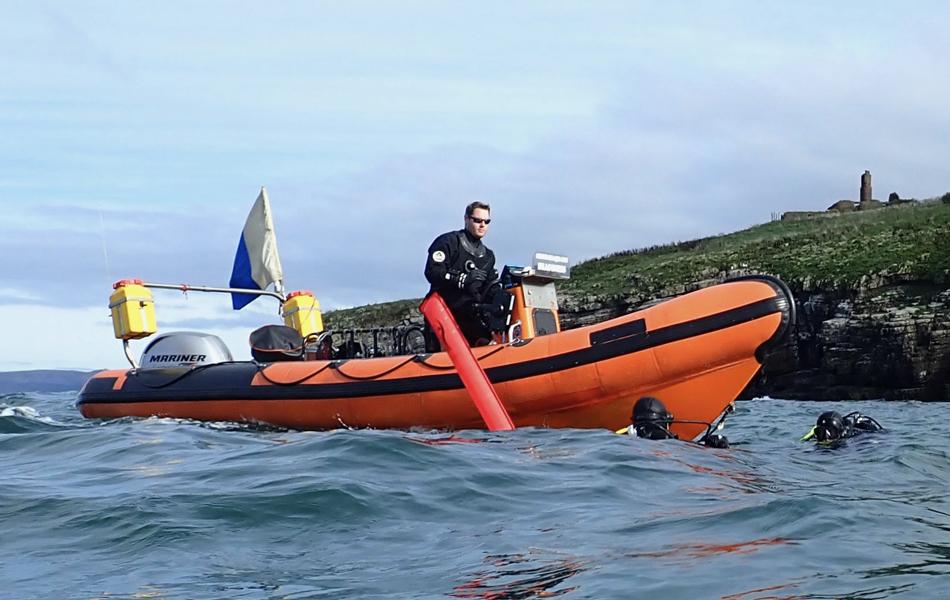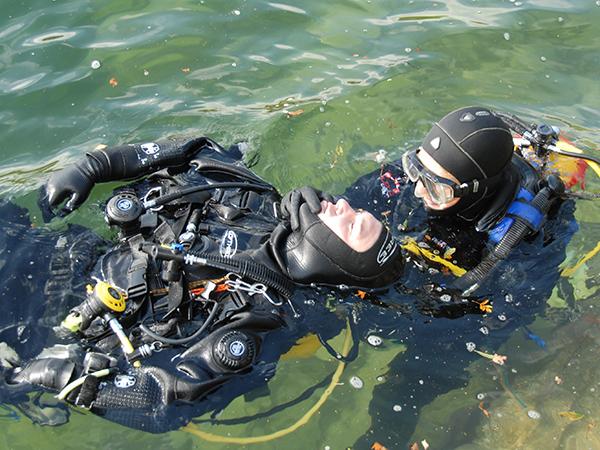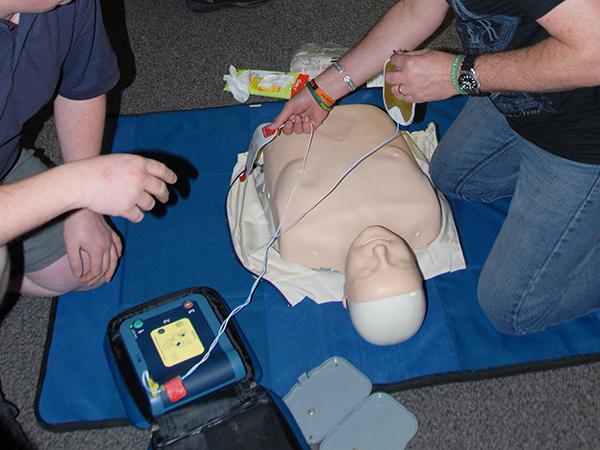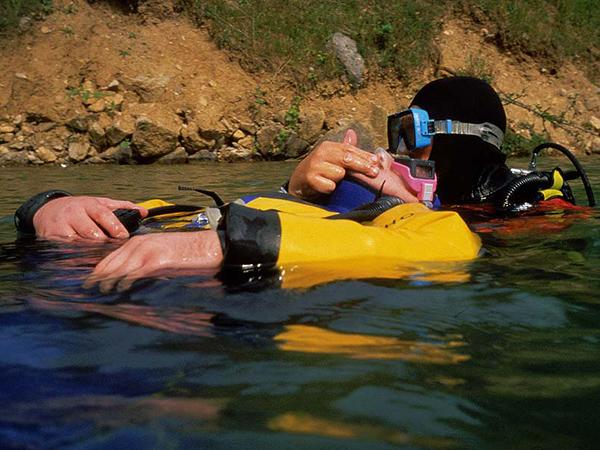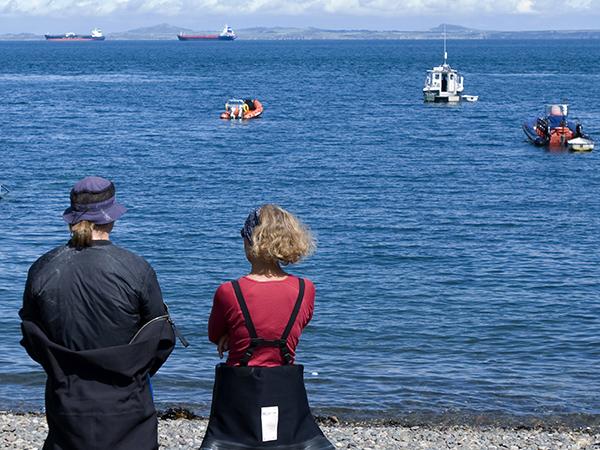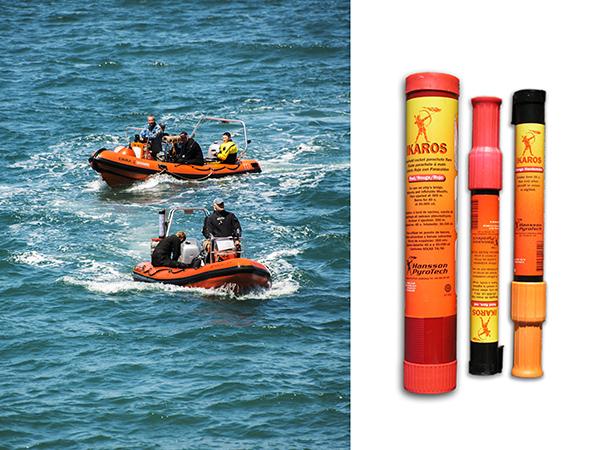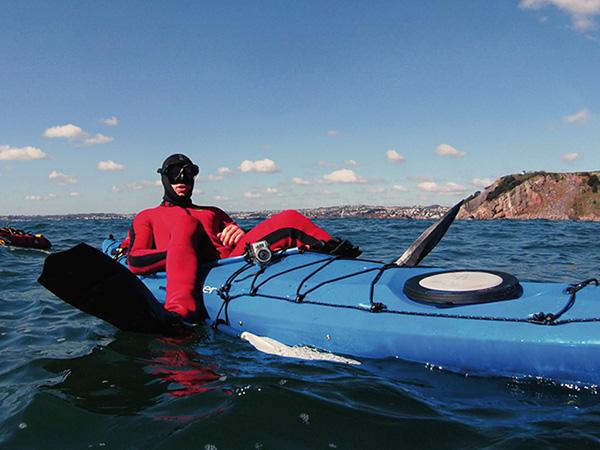Find boat safety information on lifejackets and buoyancy aids, security of seat and console fixing and emergency kill cords in the content below. A small boat safety checklist may also be useful when planning a dive trip.
Lifejackets and buoyancy aids
Lifejackets
Whilst the CDA Guidelines accept that BC's and zipped up drysuits may be adequate for the crew of a diving RIB they clearly indicate that the Coxswain should always wear a lifejacket while operating in that role, especially if when operating the boat whilst divers are in the water. This is because it is important that the person in charge of the boat is safeguarded in the event a serious incident or capsize of the boat. Where crew members fall overboard the Cox should be able to react sufficiently quickly to ensure they are recovered quickly and safely. However, should the Cox go overboard then there may be a delay whilst someone else takes control of the boat and is in a position to recover the Cox (see Kill Cord). This delay could have fatal consequences if the Cox is not supported by a Lifejacket on the surface.
Buoyancy aids
The CDA Guidelines have the following advice on the need for buoyancy aids on board a RIB.
Buoyancy Compensating Devices
Buoyancy Compensating Devices (BCDs), as used by divers, provide the user with sufficient buoyancy and adjustment capabilities while the diver is diving in the water and has a cylinder of compressed gas attached to the device. It is recommended that all personnel travelling in a RIB, while the vessel is underway and making way, should wear a BCD or an alternative buoyancy device.
Any BCD or recommended alternative buoyancy device must provide the user with additional oral inflation capabilities, sufficient buoyancy to support the person on the surface, with their face clear of the water.
Provision should be made to provide buoyancy devices of an appropriate size for any passengers that may be carried (children or people of small stature). Suitable protective clothing should also be provided.
Dry suits
Many dry suits, both membrane and neoprene, are often considered to provide adequate buoyancy for the wearer if they fell into the water. This buoyancy is only provided if the suit's zip has been completely closed, so it is essential that all dry suit zips are closed completely and checked by a buddy prior to moving away from the safety of the mooring location. Suits should not be relied upon to provide suitable flotation in the event of falling overboard and it is highly recommended that a BCD or a lifejacket is worn in addition to a closed dry suit, especially for long sea trips or in rough conditions.
Weight belts
Divers should not wear weight belts in the boat unless preparing to dive or wearing an appropriate buoyancy aid that will compensate for the additional weight.
Recreational (non-diving) Activities
Outside of when engaged in diving activities appropriate care and attention should be paid to the safety of boat occupants. When undertaking alternative activities, (eg waterskiing, fishing or just enjoying driving a boat) then appropriate safety measures should be taken especially when not wearing a drysuit or other protective clothing that provides in-water buoyancy. In most circumstances, this will warrant all on board wearing a lifejacket or appropriate buoyancy aid.
Particular care and caution should be exercised when moving a boat at the start or end of a day's activities (for example from the launch site to a pontoon or onto a mooring).
Emergency kill cord
We all love diving and some of the best diving is done from a dive rigid inflatable boat (RIB). They are great fun, fast and relatively easy to drive in good conditions.
However, imagine one day you are driving your outboard-powered RIB in a slightly choppy sea when you hit a freak wave and you and maybe some of your crew are thrown overboard. If the engine does not automatically stop, the best thing that can happen is that the boat speeds away into the distance, running out of petrol before hitting anything, you are recovered unhurt and the boat is amazingly returned to you undamaged. The worse thing that can happen is that the steering goes full lock and the boat starts to circle you at full speed with possible inevitable fatal consequences.
Understanding emergency kill cord situations
In a single engine powered RIB with cable steering; if you fall overboard the wheel (helm) will quickly turn full lock - generally that is to the right (starboard), without you holding it. This is because, under the influence of the clockwise rotating propeller, the helm is more stable at full lock clockwise.
In a boat with twin engines and contra-rotating propellers, the same thing can still happen. Though it is slightly less likely as the propeller rotation is balanced, each turning in opposite directions. Also if you have hydraulic steering the helm is more stable and more likely to stay set on the same heading.
The ‘kill cord ’is a very important safety item on any outboard powered boat, which is critical to it's safe operation. Most modern outboards incorporate an emergency engine stop switch or button, which disables the engine’s ignition system when the ‘clip’ on one end of the ‘kill cord’ lanyard is pulled out. The other end of the ‘kill cord’ is designed to be attached securely to the cox’s leg or lifejacket. However, do not be tempted to fix it to your wrist, as it is likely to get caught when operating the boat’s controls and especially the steering wheel.
Please note, do not be tempted to buy a cheap ‘kill cord’ lanyard, they are generally more than £10 each. Buy the one specified by your engine manufacturer for two reasons. Firstly it will fit and work correctly, remember this is a piece of safety equipment, and secondly cheap ‘copies’ often do not have the structural ‘inner core’ which makes it strong enough not to break when it is ‘yanked’ from the throttle control box as you fall overboard. Check carefully that the ‘kill cord’ that you have has an ‘inner core’ and is not simply a ‘red’ plastic curly cable which will most likely break in service. The result of which is a cox’n in the water and the engine potentially still running.
Do you have a spare engine ‘Kill cord’? If so where is it kept? If you went overboard with the only ‘kill cord’ attached to you, how would any remaining crew restart the engine to rescue you? If you have a secondary ‘kill cord’, would the remaining crewmembers know exactly where it was and could they find and fit it quickly to affect your rescue? All this before they lost sight of your small dark head floating on a dark sea in the large waves which most probably exist at the time of the man overboard incident. Remember this emergency situation is very unlikely to happen on a sunny day with a flat calm sea.
If you, as the cox’n became a man overboard, you may be unconscious in the water and need urgent assistance. Another good reason for always wearing a lifejacket with an automatic inflation system fitted. If the boat was heading downwind and into tide at the time, you could find that the disabled boat goes one way and the casualty with the primary ‘kill cord’ now falling off their leg to the bottom of the sea, goes in the other direction.
The solution used by the oil rig support boats, is to fix a secondary ‘kill cord’ close to the kill switch, perhaps employing a tie wrap to secure it to the throttle control box cables or other suitably close location. Then in the event of the cox’n falling overboard with the primary ‘kill cord’, attached, the secondary would be instantly and more importantly, obviously available to simply fix into position to enable the engine to be started quickly by the remaining crew members. However, do not ever be tempted to be lazy and use the ‘handily placed’ secondary ‘kill cord’ to start the engine under normal circumstances.
Please note; in the picture , this throttle control box has a diagram conveniently placed showing exactly how to fit the secondary ‘kill cord’. Imagine you are travelling downwind into tide, when you fall overboard and unknown to the rest of the crew; the secondary ‘kill cord’ is hidden away in the dry box (assuming you even have a spare on board). So with a dead engine and no way of starting it, they and the boat drift away from you, who is left stranded in the water with the primary ‘kill cord’ slipping off your leg.
Remember, once you have recovered any man overboard casualty, you must re-fit the primary ‘kill cord’ (if it is still attached to the casualty - or the spare in the dry box, if you have one) to the ‘kill switch’ and attach the other end to the cox’n again. Alternatively, if there are no more ‘kill cords’ (no spare and the primary has been lost) then simply disconnect the secondary ‘kill cord’ from the control cables so that it can be attached to the cox’n. Consider, if the sea is so rough that you have lost one cox’n, you are quite likely to be in danger of repeating the event, so drive much more carefully and seek shelter at the earliest opportunity.
This content was written by Tim Moxey Boat Handling Instructor/Diver Cox’n Assessor
Security of seat and console fixing
-
Physically try to move the seats and consoles by hand to ensure there is no movement.
-
Check for loose screws and/or evidence of any screw movement.
-
Examine the sealant between seat/consoles and the deck to check for breaks or cracks.
-
Establish if there is any water seepage under the console/seat that may indicate the sealant is not fully attached.
-
Where doubt exists, seek advice from a professional boat builder/repairer to ensure the seat pods/consoles have been attached in accordance with the manufacturer’s guidance and remain secure.

